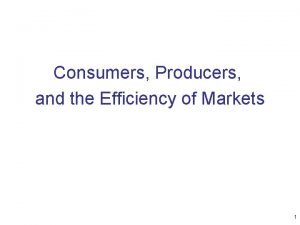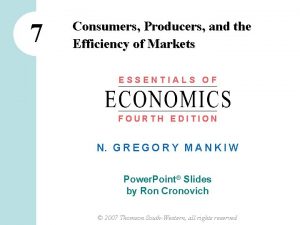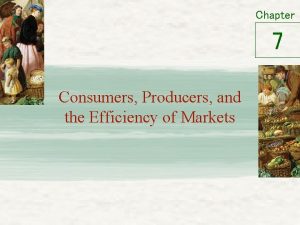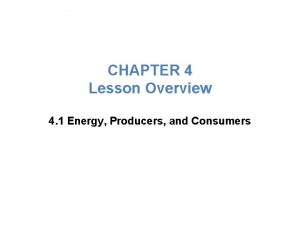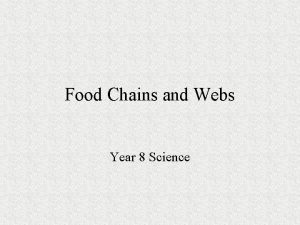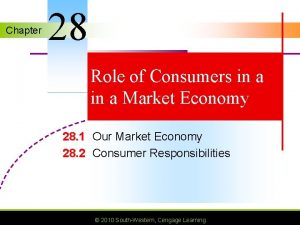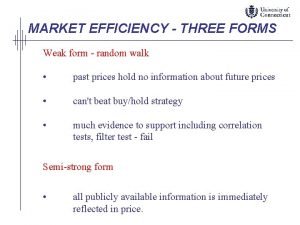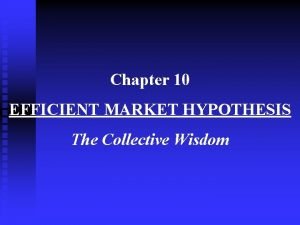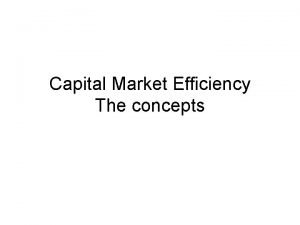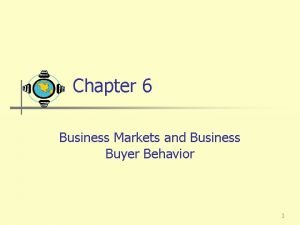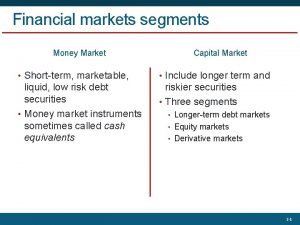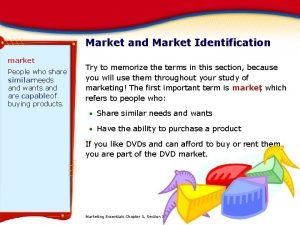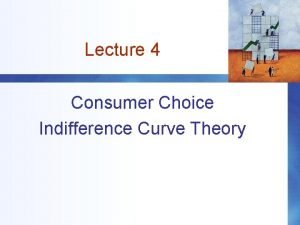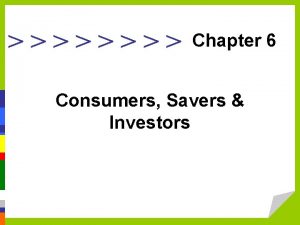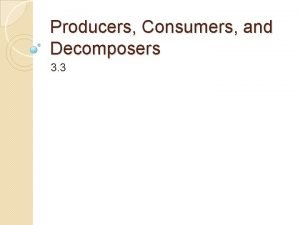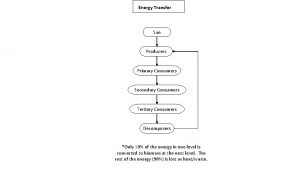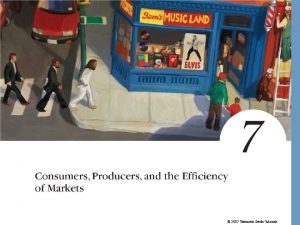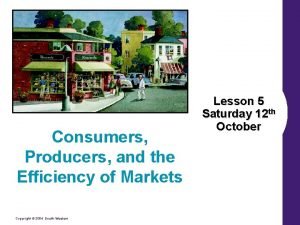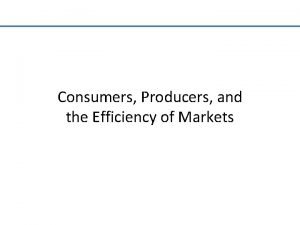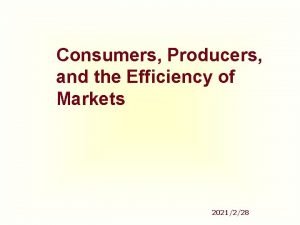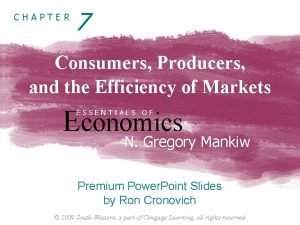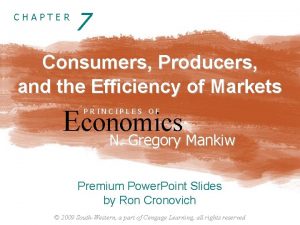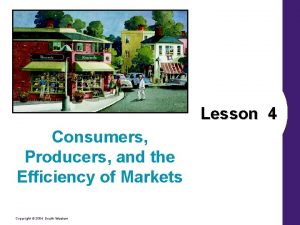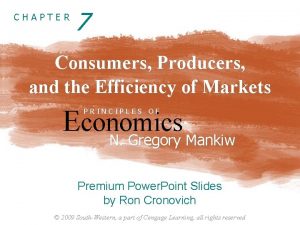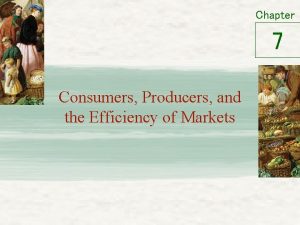Consumers Producers and Market Efficiency Lecture 5 academic












































- Slides: 44

Consumers, Producers and Market Efficiency Lecture 5 – academic year 2014/15 Introduction to Economics Fabio Landini

Where are we… • Lecture 1 : Demand supply model • Lecture 2: Elasticity and its application • Lecture 4: Demand, Supply and economic policy 2

What do we do today? • Allocative efficiency: – how do we measure the welfare of both consumers and producers? • Consumer surplus • Producer surplus • THE INVISIBLE HAND THEOREM 3

QUICK QUIZ If the equilibrium price on the market for cigarettes is equal to 10 Euro a pack, and Government introduces a MAXIMUM price equal to 12 Euro, we obtain… A) … Excess supply: the quantity supplied is greater than the quantity demanded. B). . . Scarcity: the quantity demanded is greater than the quantity supplied. C). . . No effect on the market. 4

Premise: What’s an auction? 5

Two issues 1. Is there a RIGHT price? • Consumers: prices are ALWAYS too high; • Producers: prices are ALWAYS too low. How do we understand which is the ‘right’ price? 6

Two issues 2. Is the MARKET EQUILIBRIUM (that is: p & q) right? • So far: positive analysis of the market; • Now: normative analysis; • We ask: Is the resource allocation produced by the market desirable? In which sense? • How do we measure welfare? 7

Welfare measure The consumer surplus measures the benefit that the consumer obtains from participating to the market. The producer surplus measures the same benefit for the producer. 8

Consumer surplus Willingness to pay: it is the maximum amount that the consumer is willing to pay to obtain the good. It measures the value that the consumer attaches to the good or service. 9

Consumer surplus The demand curve describes the quantity that consumers are willing to buy at different prices. The consumer surplus is the difference between the consumer’s willingness to pay and the price that is effectively paid. 10

Example: willingness to pay for a rare Elvis’s record? Consumer Willingness to pay John 100 Paul 80 George 70 Ringo 50 11

Summary: demand table Price Consumers Quantity Demanded >100 None 0 80 -100 John 1 70 - 80 John, Paul 2 50 - 70 John, Paul, George 3 < 50 John, Paul, George, Ringo 4 12

Consumer surplus and demand curve – Price=80 Price 100 Consumer surplus John (20 euro) 80 70 50 0 1 2 3 4 Quantity 13

Consumer surplus and demand curve – Price=70 Price 100 Consumer surplus John (30 euro) 80 70 50 0 Consumer surplus Paul (10 euro) Total consumer surplus (40 euro) 1 2 3 4 Quantity 14

Consumer surplus and demand curve – Price=70 Price 100 Consumer surplus John (30 euro) 80 70 50 Consumer surplus Paul (10 euro) Total consumer surplus (40 euro) Domanda 0 1 2 3 4 Quantity 15

Consumer surplus and price Consumer surplus = area in between the demand curve and the price level. There exist a negative relationship between price and consumer surplus. 16

Effects of price variations on consumer surplus Price P 1 B A Surplus of initial consumer C Demand 0 Q 1 Quantity 17

Effects of price variations on consumer surplus Price P 1 B P 2 A Surplus of initial consumer C F D Demand 0 Q 1 Q 2 Quantity 18

Effects of price variations on consumer surplus Price P 1 B P 2 A Surplus of initial consumer C E D Additional surplus for the initial consumer 0 Surplus for the new consumer Q 1 F Demand Q 2 Quantity 19

Producer surplus Supply curve • It describes the quantity that the producers are willing to sell for each price; • The willingness to sell is determined by the costs of production (measured as an opportunity cost); • As the market price increases, less efficient producers can enter the market 20

Producer surplus The producer surplus is the difference between the price paid by the consumer and the cost of production. It measures the benefit that the producer obtains from participating to the market. 21

Example: willingness to sell a rare Elvis’s record? Producer Costs Mick 900 Keith 800 Charli 600 Bill 500 22

Summary: Table of supply Price Sellers Quantity supplied P > 900 Bill, Charlie, Keith e Mick 4 800 -900 Bill, Charlie, Keith 3 600 -800 Bill, Charlie 2 500 - 600 Bill 1 None 0 P < 500 23

To measure the producer surplus with the supply curve Price 900 800 600 500 Bill’s surplus (100 euro) if p=600 0 1 2 3 Quantity 24

To measure the producer surplus with the supply curve Price Total producer surplus (500 euro) 900 800 Charlie’s surplus (200 euro) if p=800 600 500 Bill’s surplus (300 euro) if p=800 0 1 2 3 Quantity 25

To measure the producer surplus with the supply curve Price Total producer surplus (500 euro) Supply 900 800 Charlie’s surplus (200 euro) if p=800 600 500 Bill’s surplus (300 euro) if p=800 0 1 2 3 Quantity 26

Effects of price variations on producer surplus Price Supply P 1 B Surplus of initial producer C A 0 Q 1 Q 2 Quantity 27

Effects of price variations on producer surplus Price Supply P 2 P 1 B Surplus of initial producer C A 0 Q 1 Q 2 Quantity 28

Effects of price variations on producer surplus Price Supply Additional surplus for initial producer P 2 P 1 D B Surplus of initial producer F C Surplus for the new producer A 0 Q 1 Q 2 Quantity 29

Market efficiency In a market with perfect competition and no externalities: • Social welfare = consumer surplus + producer surplus 30

Consumer surplus and producer surplus in equilibrium Price A D Equilibrium price Supply E B Demand C 0 Equilibrium quantity Quantity 31

Consumer surplus and producer surplus in equilibrium Price A D Equilibrium price Supply E Producer surplus B Demand C 0 Equilibrium quantity Quantity 32

Consumer surplus and producer surplus in equilibrium Price A D Supply Consumer surplus Equilibrium price E Producer surplus B Demand C 0 Equilibrium quantity Quantity 33

Allocative efficiency obtains when the allocation of resources maximizes total surplus. Does a perfectly competitive market achieve allocative efficiency? 34

Market equilibrium and allocative efficiency In a free market: • The supply of a good goes to those consumers that evaluate the good the most. • The demand of a good is satisfied by the sellers that con produce the good at the lowest cost. • The quantity of good that maximizes the sum of consumer surplus and producer surplus is finally produced. 35

Graphical demonstration Price Supply Value for the consum er Cost for the producer 0 Equilibrium quantity The value for the consumer is greater than the cost for the producer. Value for the consum er The value for the consumer is lower than the cost for the producer. Demand Quantity 36

The invisible hand In a free market there exist several producers and consumers, each motivated by her own selfinterest. Thanks to the price system (= impersonal coordination and communication device): • Individual decisions of producers and consumers leads to an efficient allocation of resources. This is the INVISIBLE HAND THEOREM. 37

Does the invisible hand theorem always hold? No, in two cases at least: 1. Market power; 2. Externalities. In these cases we usually talk about MARKET FAILURES. 38

Market power • Market power= when consumers or producers have some control over market prices – we talk about “imperfect competition” (monopoly, oligopoly). • Market power generates inefficiencies (=“market failures”), because market prices do not reflect social cost of resources. 39

Externalities: when the decisions of consumers and producers have “external effects”, i. e. effects (both costs and benefits) on individuals that do not participate to the market. Externalities generate inefficiencies (= “market failures”), because market prices do not reflect the social cost of resources. 40

Welfare Consumer surplus and producer surplus measure the benefits that consumers and producers can derive from participating to the market 41

Efficiency An allocation of resources that maximizes the total surplus (= consumer surplus + producer surplus) is called “efficient” The existence of market power and externalities can lead to inefficient results and market failures 42

Conclusions Keep in mind: social welfare is not only efficiency, but also equity! We will talk about that later in the course…. 43

Next week Economic policy and efficiency: exercises and applications 44
 Consumers, producers, and the efficiency of markets
Consumers, producers, and the efficiency of markets Consumers producers and the efficiency of markets
Consumers producers and the efficiency of markets Chapter 7 consumers producers and the efficiency of markets
Chapter 7 consumers producers and the efficiency of markets Interpreting food webs
Interpreting food webs Primary producers
Primary producers Consumers producers decomposers
Consumers producers decomposers Is a cockroach a producer consumer or decomposer
Is a cockroach a producer consumer or decomposer Animals that eat both plants and animals
Animals that eat both plants and animals What are consumers and decomposers
What are consumers and decomposers Chapter 4 lesson 1 energy producers and consumers
Chapter 4 lesson 1 energy producers and consumers Food chain with a producer and 3 consumers
Food chain with a producer and 3 consumers Example of decomposer in food chain
Example of decomposer in food chain Energy producers and consumers lesson 1
Energy producers and consumers lesson 1 Producers consumers and decomposers worksheet
Producers consumers and decomposers worksheet Tropical rainforest animals food chain
Tropical rainforest animals food chain Anemone producers consumers and decomposers
Anemone producers consumers and decomposers What is a producer science
What is a producer science Forest tertiary consumers
Forest tertiary consumers Are all first level consumers carnivores
Are all first level consumers carnivores Producers consumers decomposers
Producers consumers decomposers Biotic components producers consumers decomposers
Biotic components producers consumers decomposers Producers respond to consumers' positive economic votes by
Producers respond to consumers' positive economic votes by Mono lake food web answers
Mono lake food web answers Opportunity cost formula
Opportunity cost formula Allocative efficiency vs productive efficiency
Allocative efficiency vs productive efficiency Allocative efficiency vs productive efficiency
Allocative efficiency vs productive efficiency Marketing segmentation targeting positioning
Marketing segmentation targeting positioning 01:640:244 lecture notes - lecture 15: plat, idah, farad
01:640:244 lecture notes - lecture 15: plat, idah, farad Market leader challenger follower nicher examples
Market leader challenger follower nicher examples Chapter 28 role of consumers in a market economy
Chapter 28 role of consumers in a market economy Three forms of market efficiency
Three forms of market efficiency Random walk efficient market hypothesis
Random walk efficient market hypothesis Capital market efficiency
Capital market efficiency Primary target market and secondary target market
Primary target market and secondary target market Decision making units
Decision making units Capital market and money market
Capital market and money market Market and market identification
Market and market identification Document sample
Document sample Money market and capital market
Money market and capital market What is a food chain
What is a food chain Is seaweed a primary producer
Is seaweed a primary producer Consumers indifference map for sneakers and jackets
Consumers indifference map for sneakers and jackets Savers and investors role in financial markets
Savers and investors role in financial markets Products and services for consumers
Products and services for consumers Products and services for consumers
Products and services for consumers
